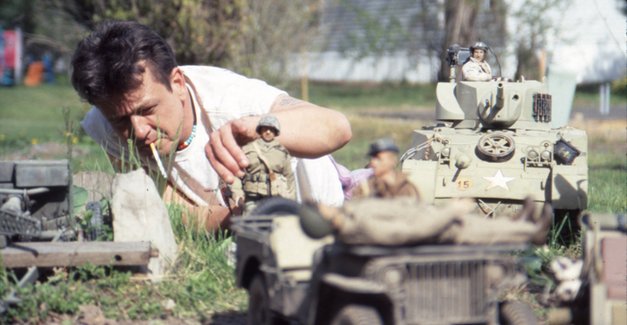Some movies span many years, generations or even centuries, yet how much do they really change? In “Hoop Dreams,” we quite literally grow up with William Gates and Arthur Agee. We see them follow their dreams, hit bumps in the road, succeed, fail and simply survive. “Hoop Dreams” is one of the most personal documentaries ever made.
Even the wonderful “Up” series of documentaries does not feel as ambitious as Steve James’s film does, despite the drastic time difference. The slow, gradual storytelling of just over four years in the lives of two inner city Chicagoans going through high school with a dream of playing basketball feels more dramatic because we know every step that got them from point A to B. They were starry-eyed kids idolizing Michael Jordan and Isiah Thomas, and when we leave them in college, it’s enough to know that their lives and their ambitions are not the same.
James started filming “Hoop Dreams” as a short film about two 8th graders’ difficulties of getting into a private school to play basketball. He could not have known he would become wrapped in the lives of these kids for over five years and 250 hours of footage. Such elements of surprise always make for the best documentary filmmaking.
But it’s easy to see why he would become so attached. The way James depicts the Gates and Agee families is to view every character as a good person with good intentions. He never pigeon holes one kid into the good guy role and the other into the bad path. The editing even shies away when we get the sense that some of the people in William and Arthur’s lives are not as upstanding as they seem, notably William’s absentee father, Arthur’s drug addicted father and Arthur’s lazy, gangbanger friend, who is never actually interviewed. Even Coach Gene Pingatore of St. Joseph High School is merely tough and is working hard for the kids, despite all the legal backlash the school would eventually file against this film.
That’s the initial beauty of “Hoop Dreams,” that although there are hardships, there are no bad intentions. And because the film follows these characters for so long, it allows anyone who did wrong to redeem themselves on camera. It asks everyone the big questions of “what if?”
These smaller stories of regret are the ones that go forgotten in this three hour long film filled with other heart wrenching and victorious imagery. One figure that surprisingly stood out to me was the high school basketball scout who discovered both kids. He promised Arthur a scholarship at St. Joseph’s and sent him on his way, but when his basketball career did not go as planned, the school revoked the money and the Agee family was left in financial turmoil. A lesser film would’ve forgotten and shunned the man responsible for the Agee’s hardship, but James doesn’t. It’s so sympathetic because we know both sides of the story.
James is not the finest commentator when it comes to narrating some of the pivotal basketball games, but he is a crafty storyteller. In the freshman and sophomore years of Arthur and William, it’s obvious to us that one kid is having more success than the other. Arthur is provided a bleak trajectory, and William is on the road to stardom. James may not have predicted their changing luck any more than we can, but his nuanced game is in then flipping their victories both on and off the court. While Arthur still maintains financial difficulty, his team is soaring to the State Championship on his back. As for William, he’s been given summer camp opportunities, basketball scholarships and a peaceful family life from the bench as he recovers from a knee injury.
This is a tough, realistic story without Hollywood predictability. It’s bittersweet and passion filled. By looking at two characters, we see that pandemonium on the basketball court goes two ways.
It also captures the spirit of Chicago better than most films ever made (“The Blues Brothers,” “Ferris Bueller,” “High Fidelity” and obviously “Chicago” all come to mind, but somehow pale in comparison to this) and feels as inspirational as most sports films without feeling like a movie obsessed with the game. The film is at its best in the Gates and Agee homes rather than on the basketball court, and it stays focused on their family drama without ever becoming systemically focused on the broken scouting process (in some ways, it even begins to recall “Moneyball”).
As is true of most documentaries, the story never ends when the cameras stop rolling. With such an emotionally charged story, we’re bound to ask where William and Arthur are now 18 years after its release, and it can be hard to hear how quickly their goals dissipated in college or how their families have passed away. Arthur’s father Bo was shot in an alley in 2004, and William’s brother Curtis died the day before 9/11.
Infamously in 1994, “Hoop Dreams” was denied a nomination for Best Documentary for an Academy Award. The body of people selecting the nominees shut off the film after just 15 minutes. But in 2012, things have not changed. James just again returned to Chicago with his film “The Interrupters,” about Chicago cops working in some of the same places Arthur and William grew up. That film too was denied inclusion on the Academy’s documentary shortlist for nominations.
It’s been said that no one would ever dare write a fictional screenplay of “Hoop Dreams’s” story, and similarly that something so ambitious could not be done again today. And although the ‘90s music and fashion has horribly dated itself, James’s story is universal and timeless. This story is being told every day in every city in America, and it’s the next generation of documentarians’ job to find them.


